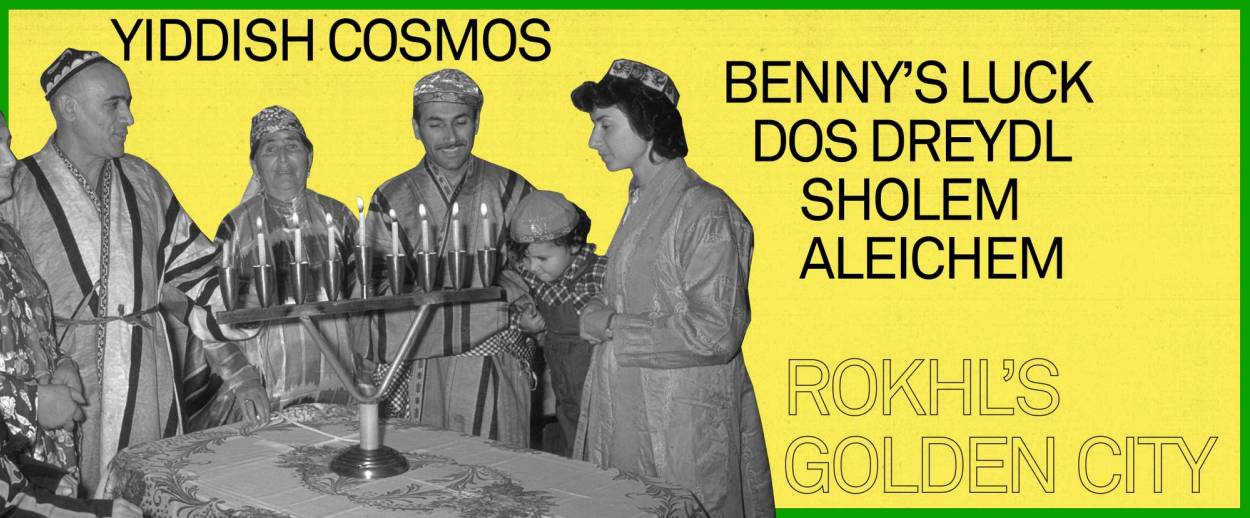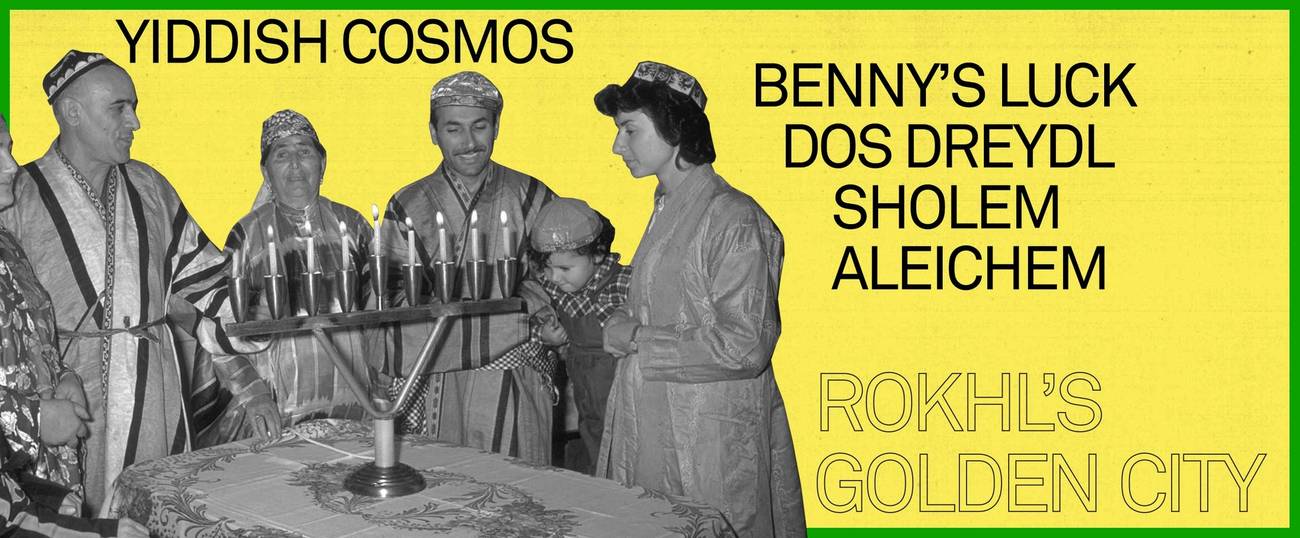A Khanike Sucker, a Rigged Dreydl, and the First Jew in Space
Rokhl’s Golden City: Happy Khanike!




“When the desire to gamble takes hold of him, there is no obstacle that a gambler cannot overcome. He will break through brick walls and iron gate, commit unimaginable crime. That’s what the evil gambling habit will make him do.”*
That’s Sholem Aleichem in the short story “Benny’s Luck” (“Dos Dreydl”), not your typical feel-good Khanike mayse. Our hero is a little boy who smokes and gambles and shirks kheyder (religious primary school) at every chance he gets, even as his saintly widowed mother is killing herself to pay his tuition. All in all, a pretty standard shtetl kid.
What’s perhaps unusual about our hero, known as the widow’s boy, is that he’s got a gambling problem. “Gambling was one of our greatest pleasures and for gambling we earned the worst tongue lashing from the rebbi. He strongly disapproved of gambling and vowed to break us of the habit once and for all.” Here the kheyder rebbe is the voice of traditional Judaism, in which gambling was very strongly frowned upon. But of course, as in all things which elicit rabbinic ire, there is a tension between what the people want and what the rabbis think they should do.
Though card playing was considered treyf, there was one day a year it was not only OK, but encouraged. Not Khanike, but Christmas. As I learned from Michael Wex, because Torah study is often done for the merit of the deceased, no Torah could be learned on Christmas should, khas v’sholem, some of that merit find its way to the guy whose birthday was being celebrated by everyone else. What else to do but the spiritual opposite of learning Torah: spending the night playing cards.
It’s strange then, that one of our most beloved festivals, Khanike, is so strongly associated with a game of chance. I speak, of course, of dreydl. Lucky for the gambling-mad hero of “Benny’s Luck,” “there was one week of the year when we were allowed to gamble. Did I say ‘allowed’? It was considered a good deed to gamble, a regular commandment! That was the week of Chanukah and we played with the dreydl.” Our narrator is perhaps exaggerating for his own justification. While the other boys enjoy playing dreydl, he alone is compelled to it. As we learn, his gambling doesn’t just cost him his lunch money, ultimately, it costs him his dignity.
“Gambling at dreydl can get heated, exciting, and upsetting. It can drive you mad to the point at which you are prepared to sell your soul.” Within the course of that fateful Khanike week, he sells his penknife, wallet, trinket box, and in a final debasement, the luxurious kolboynik (omnibus) siddur he received on his father’s yortsayt, all so he can continue playing against his best friend, Benny. Lucky Benny has a wealthy father, endless latkes and a bottomless supply of good luck. Or does he?
At the end of the story the narrator, now grown up, meets Benny on a train. Does he remember how he always used to win at dreydl? Does he? Benny reveals, between peals of laughter, that of course he remembers, the dreydl was rigged!
The story, already heartbreaking, ends on an almost nihilistic note. The game is rigged. Khanike, which we today associate with miracles and warmth, might also be a time of vulnerability, not quite a yontev, but without the pressures of kheyder and study, opening up a space in which the yetser hora was given license. But whose yetser hora? Benny’s or the widow’s son? Who is to blame for such dreadful turns of fortune? The con man or the mark?
The moment Benny reveals his swindle on the train is the dark epiphany of “Benny’s Luck.” Sholem Aleichem himself was devastated when he lost all of his family’s money in a Kiev stock exchange bubble. In “Benny’s Luck” you get the feeling Sholem Aleichem takes a certain masochistic pleasure, reveling in the guilty nightmares of a boy who has eagerly sold his every possession for the honor of becoming a Khanike sucker.
As Yiddish literary scholar Miriam Udel writes, Sholem Aleichem “viewed the swindle or con as the single most revelatory transaction in life, and children were by no means immune to its allure.” He returned to this theme again and again, burlesquing the futility (and guilt) of those who tried to make money from nothing, whether on the stock market or playing the lottery or any other game of fortune. I read this more as a critique of modern capitalism, where wealth is created out of nothing, and destroyed just as quickly, than a literary extension of rabbinical opprobrium.
Y.L. Peretz has a much gentler take on the modern market and the wheel of fortune in “The Little Hanukkah Lamp.” A poor family happens upon an undervalued piece of merchandise and is able to resell it at a handsome profit. Snuggled into their newfound wealth like it was a goose-down comforter, they quickly discard all the unfluffy trappings of Jewish life—she throws away her sheytel and he donates his sforim to the bes midrash. Quickly enough, though, their fortune turns again. And “when you live in dire need you begin to think a bit about your Jewishness.”
It’s Khanike and the couple remember their last material link to Yiddishkayt, a twisted old brass lamp. As the last night of Khanike comes to a close, a stranger shows up at the door looking to buy objets. The couple is ecstatic. They sell him the broken old lamp (what a fool!) and turn their fortunes around yet again. Their son is now a success and living in London. On a visit there they happen in to an art museum. And what do they see in this museum? It’s their old brass menorah, now displayed with great reverence!
I imagine that Peretz had a more simple, moralistic idea for “The Little Hanukkah Lamp” than Sholem Aleichem had for “Benny’s Luck.” Though you may be tempted to abandon your traditional values and replace them with something more fashionable, dos pintele yid, the tiny spark of Yiddishkayt, still remains, if you want it. In this case, the old brass menorah tucked away on a remote shelf, is both financial and spiritual redemption. Miracle upon miracle.
If you’ve ever been to the Jewish Museum in New York, or any decent Jewish museum, this ostensibly happy ending will no doubt call to mind all kinds of complicated feelings. How are we to feel among galleries full of menorahs and spice boxes? All the stuff of daily Jewish life, shorn of context, lifeless behind glass, arrayed in measured, ethnographic displays for the contemporary museum goer. Would Peretz find such an ending happy today, when such galleries are no longer a novelty but an extension of modern Jewishness? Modernity has been tough on the Jewish people, but as much as it has dealt out terrible challenges, there have also been surprising reversals, both great and small.
If you go to the Stanton Street Shul right now you can see a remarkable piece of art. It’s a giant face, one half Sholem Aleichem and one half Yuri Gagarin, the first man to venture into outer space. The face itself calls to mind a giant full moon. In 1959 the Soviets entered a new phase of their space program, sending an unmanned craft to the moon, laying the ground for Gagarin to become the first man in outer space. It was also the Sholem Aleichem centenary year. Between 1959 and 1961 there was a renaissance in Yiddish publishing in the Soviet Union, in large part due to the official decision to bring out a historic, multivolume translation of Sholem Aleichem into Russian. I meet Russians all the time who tell me they’ve read Sholem Aleichem “in the original.”
In 1961 Sovetish Heymland appeared, the first new Yiddish literary journal in the Soviet Union since the 1940s. One of the first topics it covered was the Soviet space program. And as Sovetish Heymland increased its official condemnation of the State of Israel in the late ’60s, so too did the refusenik movement pick up steam. In 1969, Boris Volynov became the first Jew to fly into space, on the Soyuz. He was originally to have flown at the same time as Gagarin, but whispers about his Jewishness grounded him at that time.
The new show at Stanton Street, Yevgeniy Fiks’ Yiddish Cosmos, contains all these visual moments, bringing them together in a way that is both disconcerting and thrilling. Fiks raises questions about futurism, varieties of exodus, and the creative potential of empty space for new Jewish identities. A feel-good Khanike miracle of the space-age kind.
*All quotes here are from Aliza Shevrin’s translation in Holiday Tales.
***
Listen: David Rogow and Rita Karin read Sholem Aleichem’s “Khanike Gelt.”
Read: “Khanike Gelt.”
Visit: Yiddish Cosmos is at Stanton Street Shul, 180 Stanton Street. It will be open to the public Sundays (1-6 p.m.), Mondays (4:30-7 p.m.) and Wednesdays (4:30-7 p.m.) through Sunday, Dec. 16. Combine it with a visit to the Tenement Museum and bagels at Russ and Daughters for a perfect afternoon with your out-of-town visitors.
ALSO: We’re spoiled for choice for live holiday music: The Klezmatics will be performing their Happy Joyous Hanukkah Woody Guthrie program with the luminous Celtic singer Susan McKeown. Sunday Dec. 2 at 8 p.m. in Brooklyn at Murmrr Theatre, 17 Eastern Parkway Brooklyn … Golem and Zion 80 (an epic double bill if there ever was one) will be rocking Drom on Dec. 5 at 7 p.m. … Sweet Is Thy Voice: The Song of Songs in Concert brings Jewish songs from around the world on the theme of Shir ha’Shirim, Thursday, Dec. 6, 7:00 p.m. … Polina Shepherd, the Yiddish Kate Bush and Psoy Korolenko, the Yiddish Psoy Korolenko, bring their brilliant new project The Wanderers to Brooklyn’s Temple Beth El on Dec. 12 … Master Yiddish teacher Perl Teitelbaum will be giving a talk on Exploring Yiddish Chanukah Through Song at Chicago YIVO 1:30 p.m., Sunday Dec. 2 at Congregation Sukkat Shalom, 1001 Central Avenue, Wilmette, Illinois. … Party with Yugntruf (Youth for Yiddish), Wednesday, Dec. 5 at 7 p.m. at Columbia University’s Deutsches Haus. … Sunday Dec. 9 the League for Yiddish presents a rare opportunity for a daylong seminar with Professor David Roskies, Yung-Yisroel: The Rebirth of Yiddish Literature in the Jewish State (for advanced Yiddish speakers and students). More details here. … And finally, the Yiddish New York nighttime programs are AMAZING. Please buy your tickets in advance as public events will sell out. And make sure you get your tickets now for the Dreaming in Yiddish event in honor of Adrienne Cooper.
You can’t help but be happy seeing the Klezmatics new impromptu music video:
***
You can help support Tablet’s unique brand of Jewish journalism. Click here to donate today.
Rokhl Kafrissen is a New York-based cultural critic and playwright.